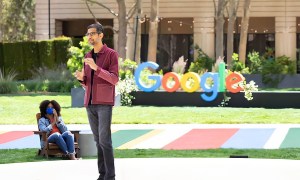
Google is making Google Assistant a whole lot better. At Google I/O 2018, the company announced a few new changes to Assistant that should help make conversation a lot more natural and conversational.
Most recently, on Monday, June 11, the Made by Google Twitter page posted a tweet (that was later deleted) noting that Google Home “can perform up to three queries at a time, so you can get more done,” CNET reports. For the time being, Multiple Actions are only available for Home users who have set their language preferences to U.S. English, but support for other languages is also planned.
Google previously announced that Assistant will be getting six new voices later in 2018 — and one of those is none other than musician John Legend. In other words, if you’re not a fan of the current Google Assistant voice, you will soon be able to change it to make it a little more personal.
New voices aren’t the only update to Assistant. Users have long wanted to be able to have a more natural conversation with Assistant, and Google is making that happen. For starters, the company is adding a feature called “Continued Conversation,” which allows you to chat with Google without having to say “Hey Google” every time you make a request. You’ll say it the first time, but after that, you’ll be able to continue talking to Google the same way you would any other conversation.
Google also recently rolled out a feature called Multiple Actions. As the name suggests, you will soon be able to ask Google to perform multiple actions in one sentence. No longer will you need to make different requests to change the thermostat and turn on the TV — now, simply say, “Hey Google, set the thermostat to 68 degrees and turn on the TV,” and it should be able to recognize the two separate actions it needs to perform. But it’s no longer just two actions that you can string together — rather, Assistant will now obey up to three commands at a time.

Ethics in technology was also a big theme at Google I/O, and along those lines, Google Assistant will now reward polite interactions with positive reinforcement. This is particularly important for kids, who are still learning how to be polite in their interactions. Now, if someone says “please” in their request, Assistant will say something like “thank you for asking so politely.” The feature is called “Pretty Please,” and is rolling out later this year.
On your phone, Google Assistant is also getting a few visual tweaks that should help make it more helpful. For starters, when you make a request, you won’t only get audio responses — you’ll also get rich visual responses in Assistant on your phone. Swipe up from a response, and you’ll also get a rundown of your day — including things like flight schedules, weather, and so on. Along with those visual changes, Google is making Assistant a little more helpful when you’re navigating in Maps. Assistant is now featured in Maps, so if you’re driving and ask for music, it won’t switch to a different screen while you’re navigating. It should be a helpful feature, and will make using Assistant in the car a little safer.

Google Assistant will also soon be able to order food for both pickup and delivery. Not only will you be able to order food using the chat-style interface like before, but you’ll also now be able to ask Assistant to simply order your usual from Starbucks, for example.
As a digital assistant, Google Assistant can do things like book tables at restaurants and book haircuts — and soon it’ll get a whole lot better at doing so. The new feature is called “Google Duplex,” and basically involves Assistant actually calling businesses to get things done. In other words, if you ask Assistant to book you a haircut, it may actually call the hair salon, and book the haircut by talking to whoever picks up. It actually sounds very natural and represents a pretty big step forward for digital assistants in general. Google has put a lot of work into ensuring that Assistant can understand the nuances of language — and based on the examples Google gave, it seems to be able to do this pretty well.
Updated on June 12: Google Home can respond to three queries at once.

